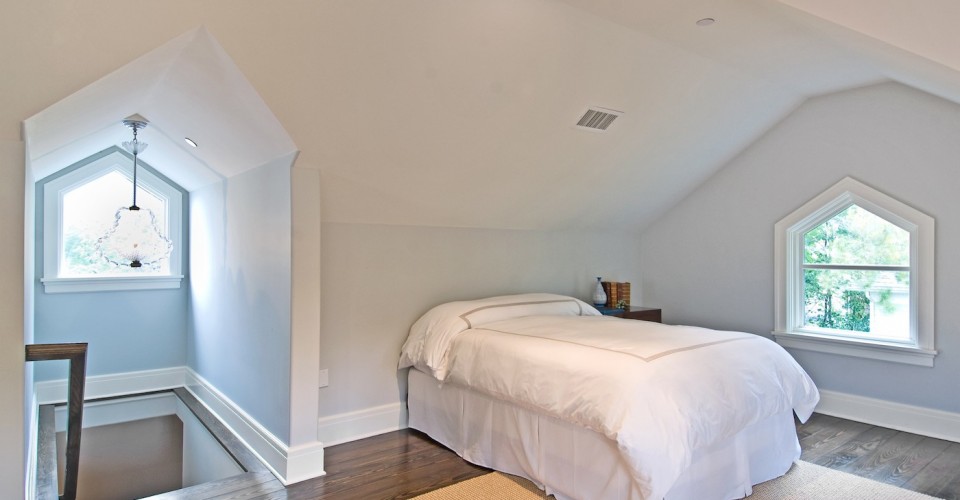Attic remodeling, converting an attic into a usable space like a bedroom, is a trend that has been rising over the last few years. Some homeowners remodel to create an additional bedroom, others may want a dedicated home office or playroom. Regardless of the motivation, an attic remodel can be an expensive undertaking so it’s wise to plan your budget accordingly.
National average costs for an attic remodel
According to Remodeling Magazine, the national average cost of an attic bedroom conversion is $49,438, and has a resale value of $41,656, making the cost versus value 84.3%. This return on investment is a growing trend. Although it peaked in 2005 at 93.5%, the cost versus value dipped to 72% during 2010 – 2013. Compared with basement remodels (77.6%), bathroom remodels (72.5%) and home office remodels (48.9%), converting your attic into a bedroom can add real value to your home. Remodeling Magazine defines an attic bedroom conversion with the following details: Convert unfinished attic space to a 15-by-15-foot bedroom and a 5-by-7-foot bathroom with shower. Include a 15-foot shed dormer, four new windows, and closet space under the eaves. Insulate and finish ceiling and walls, carpet floor. Extend existing HVAC to new space; provide electrical wiring and lighting to code. Retain existing stairs, but add rail and baluster around stairwell.
Your own attic remodel may include a different list of priorities and may not be as extensive of a remodel as the above example. Regardless of how you plan on using your space, it’s clear that adding functionality to the attic can lead to a good payoff. It’s helpful to look at neighboring homes to see how many of them have also converted attics, and how much money was spent in home improvements. To do this, download your free Porch Home Report on Porch and then look at listed home for sale near you on Realtor. The Porch report can help you make valuable decisions for your own home to make sure it’s competitive when it comes time to sell your house.
How to set the budget for an attic remodel
Although there are no set rules about how much money to put into your attic remodeling project, experts advise to invest a proportionate amount of money to your home’s valuation. For example, if you were remodeling your kitchen, experts advise spending 5% – 15% of your home’s value toward the kitchen. An attic remodel should be no more than 15% of your home’s valuation. Because remodeling the attic can entail many projects (plumbing, HVAC, stairs, house extensions, insulations, etc.) you’ll first want to put together your design needs for the space. Your pre-planning will be incredibly important: this is when you can put down on paper how you want your attic to function and what types of renovation projects you’ll need to accomplish your goals.
Your attic space design will determine the budget
Once you’ve come up with your wish list, determine who will be best to complete the work. Many homeowners choose to hire a professional, like a general contractor, to oversee the entire project – especially if you are changing your roofline, adding major plumbing or electrical. Your professional can help you make efficient decisions, file the necessary permits and create the drawings necessary to complete the task. If you are planning a minor attic remodel, like adding insulation, drywall and carpeting, your work will be less complicated and may be able to be completed on your own.
To accomplish an accurate budget, write down all the necessary changes or additions needed for your attic remodel. Be very specific about the components and line items. Next to each item, note who will be performing the work and sourcing the materials. This will give you the best idea for what type of professionals you’ll need to hire, and how large your budget will need to be. Keep in mind that not all projects are created equal. Electrical work, for example, generally has a low material cost but a high labor cost. Walls and trim also have a low material cost but a high cost of labor. Some homeowners find it helpful to have two lists; one noting absolute musts (like “full bathroom”) as well as what would be nice to add (such as “steam shower and double sink”). The cost difference between the two can have big implications to your budget.
Permits cost money
If you plan on changing any of the exterior walls or making major construction changes, it’s likely that you will need a permit. A permit is a way for the local governing body to ensure that the project is constructed up to code and that all the proper paperwork is in order. Usually your professional will apply for and pick up the permit; be wary of pros who make you do this yourself. Permits cost money to file and the actual cost is based on the scope of your project. To find out if you need a permit for your attic remodel, check with your local department of planning and development or check with your pro.
Be prepared for unexpected attic remodeling costs
As with every home improvement project, unexpected costs are common. Attics can be a source of mold, mildew, pests and roof issues. You might also need to reinforce the flooring or deal with other unexpected construction issues. Materials can be late, you may need to pay for rush orders or additional permits. It’s best to set aside 10% of your budget for unexpected costs.
Decide who will manage the attic remodel budget
Regardless of who is performing the work, it’s always the responsibility of the homeowner to manage how their money is being spent. If you are doing an DIY attic remodel, you should keep a spreadsheet of materials and other costs for the project and establish a regular routine of examining how much money you are spending. If you are working with a professional, insist on a regularly scheduled meeting to discuss all aspects of the project including the budget and the timeline. This way there shouldn’t be any large financial surprises during the construction.
Be dedicated to your attic remodel budget
Setting the budget, and sticking to it, is easier said than done. Scope creep, the tendency to add on to the project, is common and can derail your budget quickly. Some homeowners find it helpful to allocate a percentage of the budget to scope creep, others need to be resolute in their decision making. This is when it’s useful to know yourself, your tendencies, and how much wiggle-room you have in your budget. For example, upgrading your carpeting to a high-end product may not seem like a huge deal. However, you could probably find a comparable product that is more in line with your budget. One important thing to keep in mind: don’t skimp on spending money on quality professionals that you need. Electricity and plumbing is something you definitely need to have installed up to code and without issues. Don’t try to save money by not hiring the best pro to complete necessary work.
Top image credit: Benco Construction




